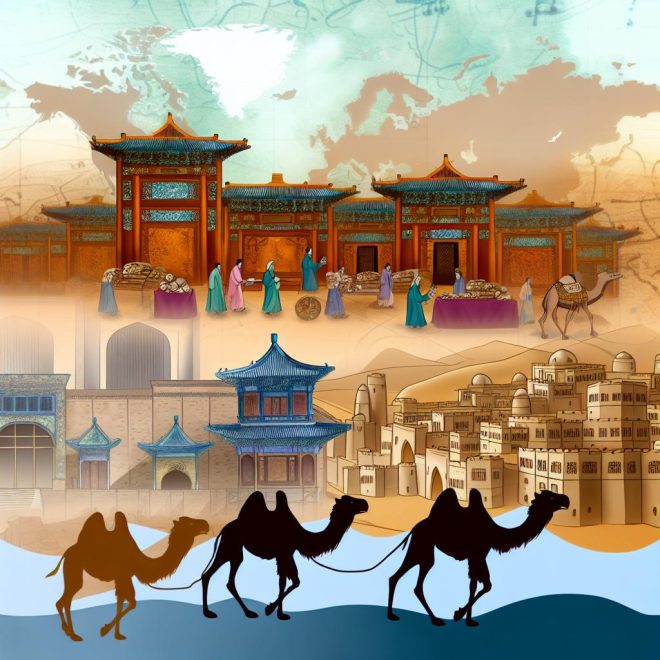Introduction to the Silk Road
The Silk Road was a vast network of trade routes that connected the ancient economies of the East and West, facilitating the exchange of goods, ideas, and cultures. It was not a single road but a series of interconnected pathways stretching across Asia and into Europe. The Silk Road flourished from around 130 BCE, during the time of the Han Dynasty in China, until the 1450s, playing a pivotal role in shaping the civilizations it touched.
The Origin and Spread of the Silk Road
The Silk Road owes its name to the lucrative silk trade originating from China, but its genesis was driven by a broader array of economic ambitions. These routes stretched thousands of miles and, over the centuries, witnessed countless caravans and sea voyages transporting goods and enriching the intercultural landscape. Originally initiated by the necessity of connecting a fractious world, the Silk Road established communication networks and economic links between empires and cities.
Trade along these routes allowed the flow of wealth in all directions, from the marbled cities of ancient Rome to the boundaries of ancient China. The Silk Road acted as a commercial backbone for economic powerhouses, enabling regions to not only exchange material goods but also create bonds through shared knowledge and cultural influences.
The Significance of Silk
Silk, the luxurious fabric that originated in China, played a central role in the trade networks that eventually became known as the Silk Road. Chinese merchants exported silk to the West, where it was highly prized and valued. This trade medium was not only a commodity but also a symbol of status and wealth, facilitating diplomatic ties and cultural exchanges. The allure of Chinese silk can be attributed to its remarkable qualities, including its soft texture, luster, and the elaborate effort required to produce it from silkworms.
The production and trade of silk also stimulated the development of agriculture and industry along the Silk Road, as lands were cultivated to produce materials and products demanded by traders. Alongside silk, other artisans adapted to this vibrant economic atmosphere by creating textiles and upholsteries to enchant the expanding trade markets.
Pathways and Major Trade Routes
The Silk Road encompassed several routes. The main terrestrial pathways ran from China through regions such as Central Asia, the Middle East, and ultimately reached the Mediterranean in the West. Water routes also formed part of the network, with maritime paths across the Indian Ocean connecting Africa, the Middle East, South Asia, and Southeast Asia. These routes interlinked continents, allowing for vast exchanges beyond terrestrial limits.
The terrestrial routes traversing through rigorous terrains of deserts, mountains, and plains included famed pathways like the Hexi Corridor linking China with what is now modern-day Central Asia. Meanwhile, maritime Silk Roads opened channels for trade across the Indian Ocean, linking littoral states to far-reaching ports and populations. This expansive network enabled the transcontinental transmission of commodities and ideologies, laying the groundwork for medieval and modern depictions of global interconnectivity.
Goods and Commodities Traded
The Silk Road was not limited to the trade of silk alone. A diverse array of goods was transported along these routes, including spices, precious metals, textiles, and ceramics. Eastern regions supplied items like jade, porcelain, and tea, while the West contributed goods such as glassware, olive oil, and wine. The interchange of these valuable items fostered economic prosperity and growth for many civilizations.
Trade exchanges along the Silk Road were not merely confined to personal luxury items; they included practical and day-to-day commodities that sustained populations and engendered prosperity. For instance, Central Asian horse traders supplied resilient breeds crucial for transporting goods across the vast expanses of the route. Meanwhile, exchanges in metallurgy led to enhanced weaponry and tools, fortifying military and agrarian efforts across empires.
Cultural and Technological Exchange
Beyond tangible goods, the Silk Road was instrumental in the exchange of cultural and technological advancements. Philosophies, religions, art, and innovations spread across the continents through traders, scholars, and missionaries. Buddhism, for instance, traveled from India to China, and technological innovations such as papermaking and gunpowder moved from East to West, influencing societies profoundly.
This route was not merely a commercial exchange but a conduit for intellectual and spiritual diffusion. The westward proliferation of ideas like Confucianism and the eastward movement of Hellenistic influences highlights the highway’s role as a melting pot of thought. Famous sites along these routes, like the city of Samarkand, became focal points for not only material commerce but academic and philosophical discourse as well.
The Silk Road’s role in linking these diverse and distant cultures created a tapestry of mutual enrichment and laid the groundwork for future global economic systems. While the traditional Silk Road has waned over the centuries, its legacy continues to influence modern trade routes and international relations. The enduring impact of the Silk Road can be observed in contemporary geopolitical strategies seeking to reconnect these regions through infrastructural initiatives echoing the historical trade routes.
In conclusion, the Silk Road was not merely a network of trade routes but a symbolic emergence of globalization in its earliest form, long before the concept was fully realized. It underscored the human impulse to connect, exchange, and evolve, resonating down the ages as an emblem of interconnected prosperity and cultural synthesis. Its correlation with modern expressions of economic ties, such as those pursued in today’s globalized world, persists as a testament to the enduring drive of human civilization towards integration and cohesion.
